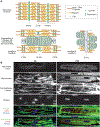Cardiomyocyte Maturation: New Phase in Development
- PMID: 32271675
- PMCID: PMC7199445
- DOI: 10.1161/CIRCRESAHA.119.315862
Cardiomyocyte Maturation: New Phase in Development
Abstract
Maturation is the last phase of heart development that prepares the organ for strong, efficient, and persistent pumping throughout the mammal's lifespan. This process is characterized by structural, gene expression, metabolic, and functional specializations in cardiomyocytes as the heart transits from fetal to adult states. Cardiomyocyte maturation gained increased attention recently due to the maturation defects in pluripotent stem cell-derived cardiomyocyte, its antagonistic effect on myocardial regeneration, and its potential contribution to cardiac disease. Here, we review the major hallmarks of ventricular cardiomyocyte maturation and summarize key regulatory mechanisms that promote and coordinate these cellular events. With advances in the technical platforms used for cardiomyocyte maturation research, we expect significant progress in the future that will deepen our understanding of this process and lead to better maturation of pluripotent stem cell-derived cardiomyocyte and novel therapeutic strategies for heart disease.
Keywords: heart disease; mammals; pluripotent stem cell; regeneration; stem cell.
Figures




References
-
- Huang CY, Maia-Joca RPM, Ong CS, Wilson I, DiSilvestre D, Tomaselli GF and Reich DH. Enhancement of human iPSC-derived cardiomyocyte maturation by chemical conditioning in a 3D environment. Journal of Molecular and Cellular Cardiology. 2019. - PubMed
Publication types
MeSH terms
Grants and funding
LinkOut - more resources
Full Text Sources

